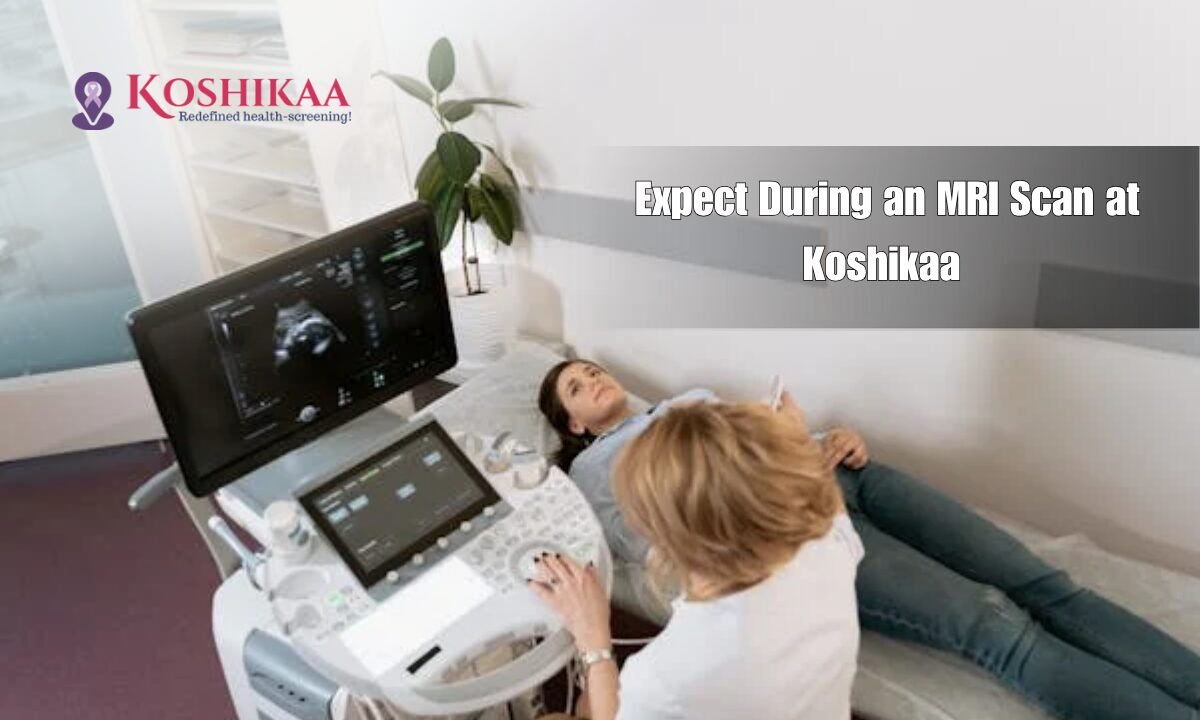Introduction
Undergoing an MRI scan can feel daunting, especially if it’s your first time. You might wonder: Is it painful? How long will it take? Will I be able to move? These are normal concerns, and at Koshikaa Screening Centre, your comfort, safety, and clarity are the top priorities.
This comprehensive guide walks you through exactly what to expect during an MRI scan at Koshikaa—from preparation to results. By demystifying the process, we help you approach your diagnostic journey with confidence, clarity, and calm.
Why Choose Koshikaa for Your MRI Scan?

Koshikaa is one of Bangalore’s most trusted diagnostic centres, known for its state-of-the-art MRI equipment, patient-first approach, and expert radiologists. Whether you’re referred for a neurological scan, spine imaging, or whole-body MRI, you’ll receive precise results in a safe and welcoming environment.
Fun Fact: Over 15,000 patients in Bangalore have trusted Koshikaa for MRI scans in the past 2 years alone.
FAQs: What to Expect During an MRI Scan at Koshikaa Screening Centre
Q1: What is an MRI scan, and why is it done?
MRI (Magnetic Resonance Imaging) uses powerful magnets and radio waves to produce detailed images of your internal organs, soft tissues, and bones—without any radiation. Doctors use MRI to detect early-stage issues like tumors, neurological disorders, ligament tears, and spinal problems.
Q2: How do I prepare for the MRI scan?
- Eat normally unless advised otherwise.
- Avoid metal accessories, watches, and clothing with zippers.
- Inform the technician if you’re claustrophobic or have implants like pacemakers.
Q3: Is it painful or dangerous?
No, MRI scans are non-invasive, painless, and extremely safe. The only challenge may be staying still during the scan to get clear images.
The Step-by-Step MRI Experience at Koshikaa
1. Check-In and Friendly Welcome
Upon arrival, you’ll be welcomed by the front desk team and guided through a quick check-in process. Expect to fill out a short medical form and submit your referral or doctor’s note.
Insider Tip: You can also book your MRI scan online via Koshikaa’s portal to skip the waiting time.
2. Pre-Scan Consultation
Before the scan, a qualified technician or radiologist will explain:
- What the MRI will scan (brain, spine, joints, etc.)
- Duration of the scan
- What sounds or sensations should to expect
- Safety protocols
If your MRI requires contrast dye, you’ll receive instructions accordingly. The contrast is injected to enhance image clarity and is usually well-tolerated.
3. Inside the MRI Room
You’ll be guided into the MRI room and asked to lie down on the scanning table. Earplugs or headphones will be offered to block out the loud scanning noises, which are normal.
The MRI machine at Koshikaa is 3 Tesla (3T)—one of the most advanced in the industry, ensuring faster scan time and sharper images.
4. During the Scan
- The procedure usually takes 15 to 45 minutes, depending on the type of scan.
- You’ll hear thumping or clicking sounds—completely normal.
- It’s crucial to stay still during the scan.
- If you feel discomfort, you can press the emergency call button provided inside the scanner.
Feeling claustrophobic? Koshikaa also offers open MRI options for patients with anxiety or special conditions.
5. After the Scan
You’ll be escorted back and given time to relax. If contrast was used, you’re advised to drink plenty of water to flush it out. There are no recovery issues, and you can resume your day right after.
When Will You Get the Results?
At Koshikaa, your MRI scan reports are prepared by board-certified radiologists and typically delivered:
- Within 24 hours for regular scans
- Within 6–12 hours for urgent cases
You can access your report via email, in person, or download it from the secure online portal
Why Patients Trust Koshikaa for MRI Scans in Bangalore
- Advanced 3T MRI technology
- Experienced radiology team
- Clean, well-maintained facilities
- Short wait times
- Transparent pricing & insurance support
- Compassionate care for elderly and pediatric patients
Real Story: Ravi, a 42-year-old IT professional, underwent a spinal MRI at Koshikaa after weeks of chronic back pain. Thanks to precise imaging and quick report turnaround, he was diagnosed with a slipped disc and began physiotherapy the next day. “I was nervous before the scan, but the staff made it incredibly easy,” he shared.
Key Benefits of Undergoing an MRI at Koshikaa
- Early detection of serious health issues
- Non-invasive and painless process
- Highly accurate results for better treatment planning
- Zero radiation exposure
- Comfort-focused facilities for a stress-free experience
Ready to schedule your scan? Learn more and book online at Koshikaa’s MRI Scan in Bangalore.
Conclusion
An MRI scan doesn’t have to be intimidating when you know what to expect, especially at a patient-centered facility like Koshikaa. With advanced imaging technology, expert radiologists, and a compassionate support team, your MRI experience can be both efficient and reassuring.
If you’re in Bangalore and need accurate diagnostics, don’t leave it to chance. Choose Koshikaa for a scan that’s smart, smooth, and stress-free.

